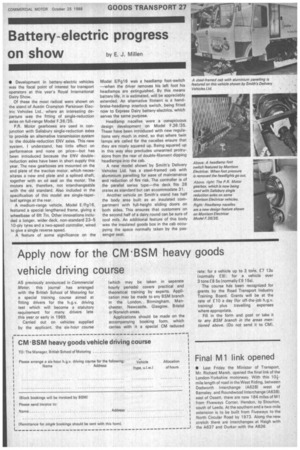Battery-electric progress
Page 29

If you've noticed an error in this article please click here to report it so we can fix it.
on show by E. J. Millen
• Development in battery-electric vehicles was the focal point of interest for transport operators at this year's Royal International Dairy Show.
Of these the most radical were shown on the stand of Austin Crompton Parkinson Electric Vehicles Ltd., where an interesting departure was the fitting of single-reduction axles on full-range Model F.36/35.
P.R. Motor gearboxes are used in conjunction with Salisbury single-reduction axles to provide an alternative transmission system to the double-reduction ENV axles. This new system, I understand, has little effect on performance and none on price—but has been introduced because the ENV doublereduction axles have been in short supply this year. The new gearboxes are mounted on the end plate of the traction motor, which necessitates a new end plate and a splined shaft, together with an oil seal on the motor. The mo,tors are, therefore, not interchangeable with the old standard. Also included in the specification of this model are single-taperleaf springs at the rear.
A medium-range vehicle, Model E /Fg16, featured a special lengthened frame, giving a wheelbase of 6ft 7in. Other innovations included a longer, wider deck, non-standard 23-5 10-ply tyres and a two-speed controller, wired to give a single reverse speed.
A feature of some significance on the Model E/Fg16 was a headlamp foot-switch —when the driver removes his left foot his headlamps are extinguished. By this means battery life, it is estimated, will be appreciably extended. An alternative fitment is a handbrake-headlamp interlock switch, being fitted now to Express Dairy battery-electrics, which serves the same purpose.
Headlamp nacelles were a conspicuous design development on Model F.36/35. These have been introduced with new regulations very much in mind, so that where twin lamps are called for the nacelles ensure that they are nicely squared up. Being squared up in this way also precludes unwanted protrusions from the rear of double-filament dipping headlamps into the cab.
A new model shownby Smith's Delivery Vehicles Ltd. has a steel-framed cab with aluminium panelling for ease of maintenance and reduction of fire risk. The controller is of the parallel series type—the deck fits 28 crates as standard but can accommodate 31.
Another vehicle on Smith's stand has half the body area built as an insulated compartment with full-height sliding doors on both sides. This ensures that customers on the second half of a dairy round can be sure of cool milk. An additional feature of this body was the insulated goods box in the cab occupying the space normally taken by the passenger seat.
















































































































